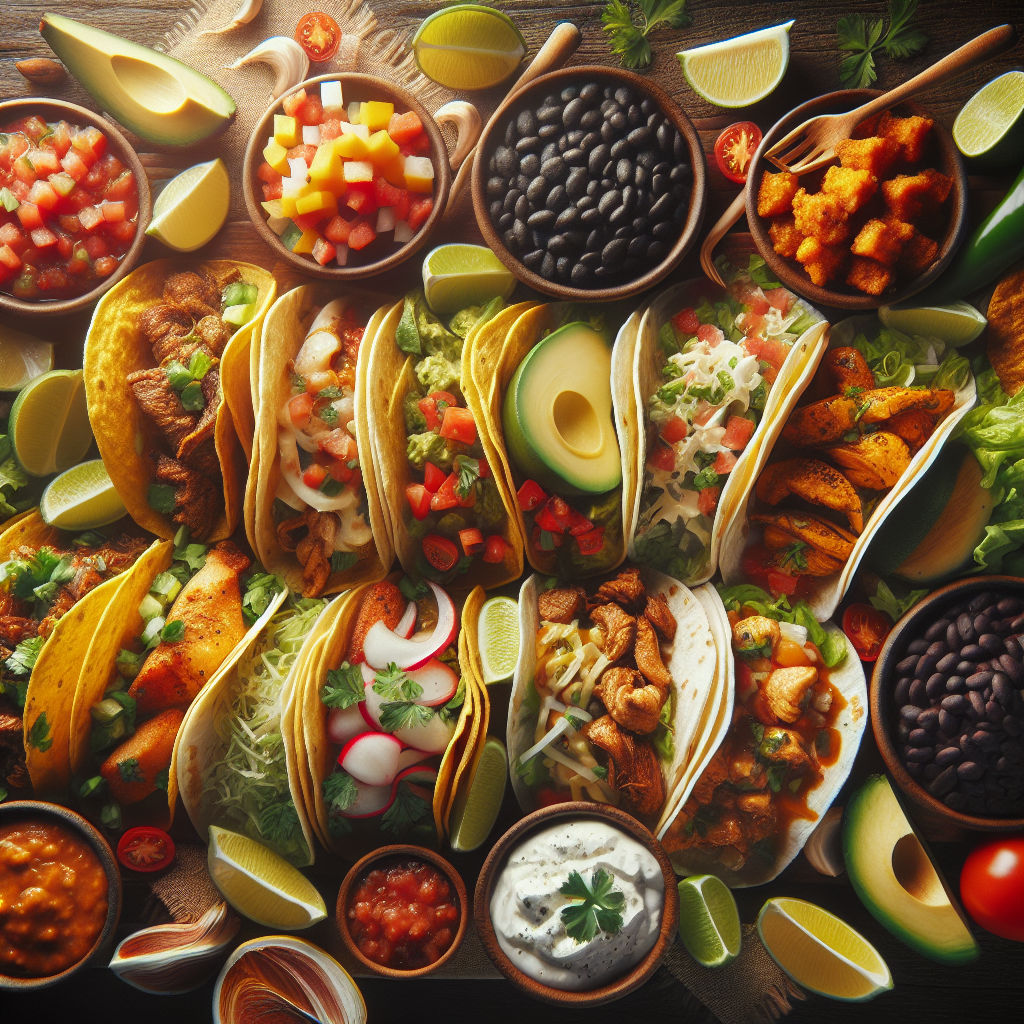Calling all food lovers and culinary adventurers! Get ready to embark on a tantalizing journey through Latin American flavors at Tastepan.com. We have curated a treasure trove of mouthwatering recipes that will transport you to the vibrant streets of Mexico, Argentina, and beyond. From the iconic and irresistible tacos to the savory and flaky empanadas, our step-by-step instructions, expert tips, and ingredient lists will empower you to create authentic and delicious meals that will impress and satisfy. So, grab your apron, sharpen your knives, and get ready to savor the rich and diverse culinary traditions of Latin America.

Traditional Tacos
Tacos are a beloved staple in Latin American cuisine, famously known for their versatility and delectable flavors. But have you ever wondered about the origins of this delectable dish and the different types and fillings that make each taco unique? Let’s delve into the fascinating world of traditional tacos!
Origins of Tacos
The history of tacos can be traced back to ancient times, where the indigenous people of Mesoamerica first began using tortillas as a vessel for various fillings. The word “taco” is derived from the Nahuatl language, spoken by the Aztecs, and it initially referred to the way tortillas were rolled up to hold food.
Types of Tacos
From street vendors to high-end restaurants, tacos can be found in many different forms throughout Latin America. Some popular types include:
- Taco al Pastor: Originating from Mexico, this type of taco is made with thin slices of marinated pork, pineapple, onions, and cilantro.
- Taco de Pescado: Popular in coastal regions, this taco features a crispy fish fillet topped with cabbage slaw, mayonnaise, and lime juice.
- Taco de Carnitas: Hailing from Mexico, these tacos are filled with tender, slow-cooked pork chunks, onions, and cilantro.
- Taco de Barbacoa: This taco is made with succulent, slow-cooked beef, traditionally prepared in an underground pit.
The possibilities are endless when it comes to taco varieties, and each region has its own unique spin on this classic dish.
Classic Taco Fillings
When it comes to filling tacos, the options are limitless. Some classic fillings include:
- Carne Asada: Grilled and seasoned beef, sliced and served with onions, cilantro, and a squeeze of lime.
- Pollo Tinga: Shredded chicken cooked in a flavorful tomato and chipotle sauce, topped with lettuce, cheese, and sour cream.
- Cochinita Pibil: A Yucatan specialty, this filling features slow-roasted pork marinated in citrus and achiote paste, served with pickled onions.
- Pescado Guisado: A flavorful fish stew that is shredded and served with chopped tomatoes, onions, and cilantro.
The key to a delicious taco is the combination of flavors and textures, from the succulent meats to the fresh toppings, making every bite a burst of flavor.
Delicious Empanadas
Empanadas are another beloved Latin American culinary delight that has captured the hearts and taste buds of people around the world. These filled pastries come in various shapes and sizes and are enjoyed as a snack, appetizer, or even a main course. Let’s delve into the rich history of empanadas and explore the mouthwatering varieties and fillings they offer.
History of Empanadas
Empanadas have a diverse history that spans several continents. They can be traced back to Spain, where they were influenced by the Moorish tradition of filling dough with meat and vegetables. The Spanish then brought this culinary creation to the New World during the colonial era, where it quickly became a popular dish among the locals.
Varieties of Empanadas
The beauty of empanadas lies in their versatility. From region to region, you’ll find variations in the dough, fillings, and even cooking methods. Some popular types of empanadas include:
- Empanada de Carne: This classic empanada is filled with seasoned ground beef, onions, and olives.
- Empanada de Pollo: Shredded chicken, sautéed with onions, peppers, and spices, makes for a mouthwatering filling.
- Empanada de Queso: A cheese lover’s delight, these empanadas are filled with melted cheese, often combined with herbs or vegetables.
- Empanada de Jamón y Queso: A favorite in many Latin American countries, this empanada combines ham, cheese, and sometimes a touch of tomato sauce.
The choices are endless when it comes to empanadas, and each one offers a unique and satisfying culinary experience.
Popular Empanada Fillings
Empanadas can be filled with almost anything your heart desires, giving them their trademark versatility. Some popular fillings include:
- Spinach and Cheese: The combination of creamy cheese and vibrant spinach creates a flavorful and vegetarian-friendly empanada.
- Seafood: From shrimp to crab or even a mix of seafood, these empanadas offer a taste of the ocean with every bite.
- Corn and Cheese: Sweet corn kernels paired with melted cheese create a delightful filling that bursts with flavor.
- Vegetable Medley: Embrace the goodness of fresh vegetables, like bell peppers, zucchini, and carrots, seasoned to perfection.
Whether you prefer savory or sweet, vegetarian or meat-filled, empanadas have something to satisfy every palate and culinary desire.

Enchanting Arepas
Arepas, a traditional dish hailing from Venezuela and Colombia, have gained popularity around the world due to their delicious taste and endless possibilities for customization. Whether you’re looking for a breakfast option, a snack, or a meal, arepas have got you covered. Let’s explore the world of arepas and discover their different types and mouthwatering fillings and toppings.
Introduction to Arepas
Arepas are round, flatbreads made from pre-cooked cornmeal dough, known as masa. Originating from indigenous tribes, they have been a staple in the diet of Venezuelans and Colombians for centuries. Today, they are enjoyed by people of all backgrounds, with variations that cater to different tastes and dietary preferences.
Different Types of Arepas
In both Venezuela and Colombia, you’ll find a wide range of arepas, each with its own unique characteristics. Some popular types include:
- Arepas Blancas: These arepas are the traditional version, made with only cornmeal, water, and salt, giving them a pure and simple flavor.
- Arepas de Choclo: This type of arepa is made with fresh corn kernels, lending it a slightly sweeter taste and a more vibrant color.
- Arepas Reina Pepiada: Named after a beauty queen, these arepas are filled with a delicious mixture of shredded chicken, avocado, and mayonnaise.
The beauty of arepas lies in their ability to adapt to different tastes, making them a versatile and satisfying dish.
Arepas Fillings and Toppings
The filling and toppings you choose for your arepas are what truly make them enchanting. From traditional fillings to fusion creations, the possibilities are endless. Some popular fillings and toppings include:
- Pernil: Slow-roasted pork, marinated in a blend of spices and herbs, creates a mouthwatering filling for your arepa.
- Black Beans and Cheese: The combination of creamy black beans and melted cheese is a classic and comforting choice.
- Shredded Beef: Seasoned and tender shredded beef, known as carne mechada, is a beloved filling that adds a burst of flavor.
- Avocado and Tomato: Refreshing and full of nutrients, ripe avocado and juicy tomato slices make for a vibrant and satisfying topping.
Whether you prefer savory or prefer a touch of sweetness, the versatility of arepas allows you to get creative and customize your own culinary masterpiece.
Delectable Ceviche
Ceviche is a refreshing and flavorful dish that showcases the vibrant and diverse flavors of Latin America. With its origins in the coastal regions, ceviche has become a culinary staple known for its tangy citrus marinade and the freshness of its seafood. Let’s dive into the world of ceviche and explore its regional variations and the best fish for making this delightful dish.
Ceviche: A Latin American Staple
Ceviche is a dish that can be found throughout Latin America, with each country adding its own unique twist. What makes ceviche special is the process of “cooking” the seafood using the acidity of citrus juices, typically lime or lemon. The result is a dish bursting with bright flavors and a delightful balance of tanginess.
Regional Variations of Ceviche
From Mexico to Peru, each country has its own version of ceviche. Some popular regional variations include:
- Mexican Ceviche: This ceviche often includes a mix of diced fish, shrimp, or shellfish, combined with tomatoes, onions, cilantro, and spices for a bold and zesty flavor.
- Peruvian Ceviche: Considered by many as the birthplace of ceviche, Peruvian ceviche features large chunks of raw fish marinated in a delicious blend of lime juice, garlic, and aji amarillo peppers.
- Ecuadorian Ceviche: In Ecuador, ceviche often includes shrimp or fish marinated in lime juice and orange juice, offering a subtly sweet and tangy flavor profile.
These are just a few examples, but no matter where you are in Latin America, you’ll find variations of ceviche that highlight the unique flavors and ingredients of each region.
Best Fish for Making Ceviche
Choosing the right fish is crucial when making ceviche, as it needs to be fresh and firm enough to hold up to the acidity of the citrus marinade. Some popular choices include:
- Snapper: A versatile white fish that is firm but delicate in flavor, making it a perfect choice for ceviche.
- Mahi-Mahi: With its meaty texture and mild flavor, mahi-mahi is a popular choice for those who prefer a heartier ceviche.
- Halibut: This delicate and flaky fish lends itself well to ceviche, absorbing the flavors of the marinade beautifully.
When choosing fish for your ceviche, always ensure it is fresh and of high quality, as this will greatly enhance the taste and texture of the final dish.
From the tangy marinade to the assortment of fresh seafood, ceviche is a dish that showcases the vibrant flavors of Latin America and is sure to delight seafood enthusiasts around the world.

Savor the Flavor of Pupusas
Pupusas are a delightful and satisfying dish that hails from El Salvador but has gained popularity across Latin America and beyond. These thick and fluffy corn tortillas are filled with a variety of savory ingredients, making them a beloved staple of Salvadoran cuisine. Let’s explore the world of pupusas and discover their traditional fillings and the accompaniments that enhance their flavor.
What are Pupusas?
Pupusas are made from masa de maiz, a dough made from finely ground cornmeal, which is then shaped into thick, round discs. The dough is then filled with a variety of ingredients, such as cheese, beans, and meats, before being cooked on a griddle until golden brown. The result is a delicious and comforting dish that is enjoyed by people of all ages.
Traditional Pupusa Fillings
While pupusas can be filled with a wide range of ingredients, some traditional fillings are particularly beloved in El Salvador. These include:
- Queso: The most basic and popular filling, queso pupusas are filled with a blend of soft cheeses, such as quesillo or mozzarella.
- Revuelta: A flavorful combination of cheese, cooked pork, and refried beans, revuelta pupusas offer a savory and satisfying experience.
- Chicharrón: Pupusas filled with chicharrón, or crispy pork cracklings, provide a crispy and savory texture that is hard to resist.
- Ayote: For a vegetarian option, ayote pupusas are filled with seasoned squash, offering a delightful blend of flavors.
These traditional fillings are just the tip of the iceberg, as pupusas can be customized to suit your taste buds, ensuring a unique and enjoyable dining experience.
Accompaniments to Pupusas
Pupusas are often served alongside condiments and accompaniments that enhance their flavor and add an extra layer of enjoyment. Some popular accompaniments include:
- Curtido: A type of pickled cabbage slaw that adds a tangy and crunchy element to the pupusa.
- Salsa Roja: A spicy tomato-based sauce that complements the savory flavors of the pupusas.
- Tomato Sauce: A milder alternative, tomato sauce can be drizzled over the pupusas for a burst of rich flavor.
- Guacamole: Creamy and full of flavor, guacamole is a refreshing accompaniment that pairs well with the pupusa.
These accompaniments not only add delicious flavors but also provide a textural contrast that elevates the overall dining experience.
Whether enjoyed as a snack, a main course, or even for breakfast, pupusas are a delightful dish that brings together the flavors and traditions of El Salvador.

